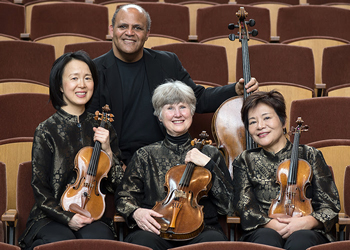by David Kulma

Beethoven’s 17 works for two violins, viola, and cello are at the center of the chamber music repertoire. Professional quartets are measured on their ability to perform this demanding music at the highest level. And the Amici, all of whom have day jobs in The Cleveland Orchestra, are equal to the task.
During the three works performed on this concert, violinists Takako Masame and Miho Hashizume, violist Lynne Ramsey, and cellist Ralph Curry played with intense clarity of intonation, rhythm, timing, and texture. They were a joy to listen to throughout.
The first half featured quartets from Beethoven’s early and middle periods. The Amici played the early work, No. 6 in B-flat, Op. 18, No. 6, with grace and precision. They tossed off the jovial, yet difficult scherzo with aplomb, and underlined the dramatic contrast in the final movement between La Malinconia — with its slow sad ascending lines that rise to melodic turns — and the boisterous, bouncing fast music that ends the piece.
The middle quartet, No. 8 in e, Op. 59, No. 8, shows Beethoven in one of his darker moods. The brooding opening movement was arresting, with meticulously played syncopations. A lovely lightness pervaded the sunnier sentimental slow movement. The off-kilter scherzo with its Russian-tune trio was just right, and the finale, with its quick-stepping harmonic swerves that regularly delay the hoped-for major, was played with brio.
As lovely and well played as these two quartets were, the late-period quartet, No. 13 in B-flat, Op. 130, was the highlight of the afternoon. Beethoven’s late style is more elaborate. He regularly uses contrapuntal textures where each player has an important line rather than chugging away on one note. He also changes textures more quickly, which requires the players to deftly handle slight shifts in weight and emphasis. The Amici scaled this more complex musical peak with depth, focus, and zeal.
Each of the six movements was well conceived and expertly played. The two slow ones were gorgeous statements, while the Presto and Alla danza tedesca were breathless and buoyant, respectively. As Donald Rosenberg said in his pre-concert talk, this quartet originally ended with the gargantuan Große Fuge, but Beethoven’s publishers asked him to write a new movement, and make the Fuge a separate opus. The replacement, lighter and more direct, as well as being the last important music Beethoven ever wrote, ended this concert beautifully.
That the Amici play this well together makes their next Beethoven installment in 2019 a must hear.
Published on ClevelandClassical.com February 22, 2018.
Click here for a printable copy of this article


